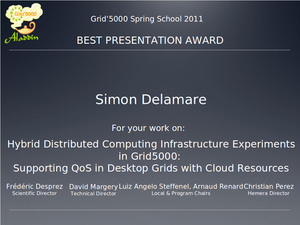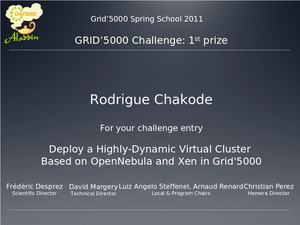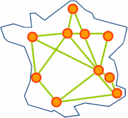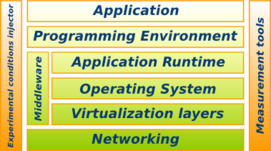Grid5000:Home: Difference between revisions
No edit summary |
No edit summary |
||
| Line 47: | Line 47: | ||
== ALADDIN-G5K : ensuring the development of '''Grid'5000''' == | == ALADDIN-G5K : ensuring the development of '''Grid'5000''' == | ||
For the 2008-2012 period, Engineers ensuring the development and day to day support of the infrastructure are mostly provided by INRIA, under the ''ADT ALADDIN-G5K'' initiative. | For the 2008-2012 period, Engineers ensuring the development and day to day support of the infrastructure are mostly provided by INRIA, under the ''ADT ALADDIN-G5K'' initiative. | ||
==[[Hemera|HEMERA: Demonstrating ambitious up-scaling techniques on '''Grid'5000''']] == | |||
[[Hemera|Héméra]] is an INRIA Large Wingspan project, started in 2010, that aims at demonstrating ambitious up-scaling techniques for large scale distributed computing by carrying out several dimensioning experiments on the Grid’5000 infrastructure, at animating the scientific community around Grid’5000 and at enlarging the Grid’5000 community by helping newcomers to make use of Grid’5000. | |||
===Sites:=== | ===Sites:=== | ||
{|width="75%" cellspacing="3" | {|width="75%" cellspacing="3" | ||
Revision as of 16:08, 28 April 2011
|
|
Latest updates from Grid'5000 users
- Experiments
{{#experiments:3|||**}}
- Publications
Five random publications that benefited from Grid'5000 (at least 2925 overall):
- Khaled Arsalane, Guillaume Pierre, Shadi Ibrahim. Toward Stream Processing Elasticity in Realistic Geo-Distributed Environments. IC2E 2024 - 12th IEEE International Conference on Cloud Engineering, IEEE, Sep 2024, Paphos, Cyprus. pp.1-9. hal-04655408v2 view on HAL pdf
- Eva Giboulot, Teddy Furon. WaterMax: breaking the LLM watermark detectability-robustness-quality trade-off. NeurIPS 2024 - 38th Conference on Neural Information Processing Systems, Dec 2024, Vancouver, Canada. pp.1-34. hal-04766606 view on HAL pdf
- Marc Jourdan, Clémence Réda. An Anytime Algorithm for Good Arm Identification. 2024. hal-04688141 view on HAL pdf
- Vania Marangozova, Angelo Gennuso. K8S Auto-Scaler Coordinators. Université Grenoble - Alpes. 2024. hal-04963348 view on HAL pdf
- Pierre-Etienne Polet. Portage des chaînes de traitement sonar sur architecture hétérogène : conception et évaluation d'un environnement de programmation basé sur les tâches moldables. Informatique cs. Ecole normale supérieure de lyon - ENS LYON, 2024. Français. NNT : 2024ENSL0004. tel-04633261 view on HAL pdf
Latest news
Grid'5000 Spring School 2011 awards announced
|
Best presentation award to Simon Delamare |
Challenge Winner 2011 to Rodrigue Chakode |
The winning challenge entry demonstrated Deploying a Highly-dynamic Virtual Cluster Based on OpenNebula and Xen in Grid'5000, with SVMSched, and wins an archos Android tablet.
Grid'5000 users selected for the second round of the SCALE'2011 challenge
The following paper has been selected for the second round of the international SCALE'2011 challenge organized in conjunction with the IEEE CCGRID'2011 to be held on May 23-26, 2011 in Newport Beach, CA, USA. M. Djamaï, B. Derbel, N. Melab. A Large-Scale Pure P2P Approach for the B&B Algorithm. (IEEE/ACM CCGRID/SCALE’2011, Newport Beach, USA, May 23-26, 2011).
The paper presents a peer-to-peer Branch-and-Bound algorithm for solving large-scale challenging combinatorial optimization problems. The high scalability of the algorithm is demonstrated through intensive experiments performed on Grid'5000. The work is strongly related to the scientific challenge Large scale computing for combinatorial optimization problems of the INRIA Hemera large wingspan project.
Grid'5000 Tutorial at Renpar'20, to be held in Saint-Malo, May 10th
In the morning, talks will focus on experiment-driven research, open science and how Grid'5000 is a tool to be used in this context. The afternoon will be dedicated to concrete tutorials on how to access and to use Grid'5000. These tutorials will be based on the tutorials available at the Tutorial Home.
Grid'5000 at a glance
- Grid'5000 is a scientific instrument for the study of large scale parallel and distributed systems. It aims at providing a highly reconfigurable, controlable and monitorable experimental platform to its users. The initial aim (circa 2003) was to reach 5000 processors in the platform. It has been reframed at 5000 cores, and was reached during winter 2008-2009.
- The infrastructure of Grid'5000 is geographically distributed on different sites hosting the instrument, initialy 9 in France. Porto Alegre, Brazil is now officially becoming the 10th site.
ALADDIN-G5K : ensuring the development of Grid'5000
For the 2008-2012 period, Engineers ensuring the development and day to day support of the infrastructure are mostly provided by INRIA, under the ADT ALADDIN-G5K initiative.
HEMERA: Demonstrating ambitious up-scaling techniques on Grid'5000
Héméra is an INRIA Large Wingspan project, started in 2010, that aims at demonstrating ambitious up-scaling techniques for large scale distributed computing by carrying out several dimensioning experiments on the Grid’5000 infrastructure, at animating the scientific community around Grid’5000 and at enlarging the Grid’5000 community by helping newcomers to make use of Grid’5000.
Sites:
- Grid'5000 is a research effort developping a large scale nation wide infrastructure for large scale parallel and distributed computing research.
- 17 laboratories are involved in France with the objective of providing the community a testbed allowing experiments in all the software layers between the network protocols up to the applications.
The current plans are to extend from the 9 initial sites each with 100 to a thousand PCs, connected by the RENATER Education and Research Network to a bigger platform including a few sites outside France not necessarily connected through a dedicated network connection. Sites in Brazil and Luxembourg should join shortly.
All sites in France are connected to RENATER with a 10Gb/s link.
This high collaborative research effort is funded by INRIA, CNRS, the Universities of all sites and some regional councils.
Initial Rationale
The foundations of Grid'5000 have emerged from a thorough analysis and numerous discussions about methodologies used for scientific research in the Grid domain. A report presents the rationale for Grid'5000.
In addition to theory, simulators and emulators, there is a strong need for large scale testbeds where real life experimental conditions hold. The size of Grid'5000, in terms of number of sites and number of processors per site, was established according to the scale of the experiments and the number of researchers involved in the project.
Current funding
As from June 2008, INRIA is the main contributor to Grid'5000 funding.
INRIA |
CNRS |
UniversitiesUniversity Joseph Fourier, Grenoble |
Regional councilsAquitaine |






